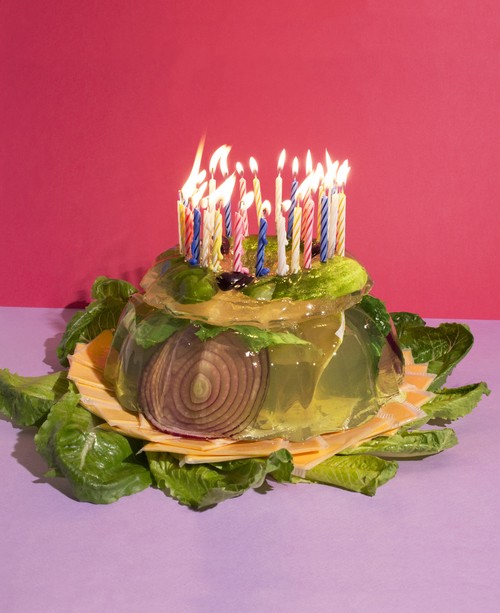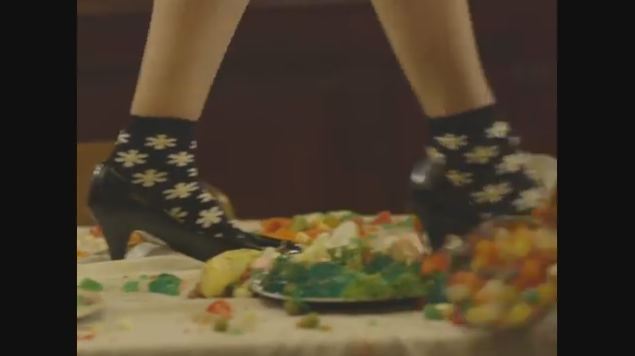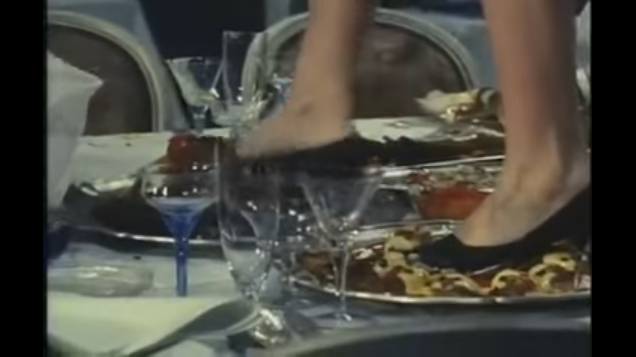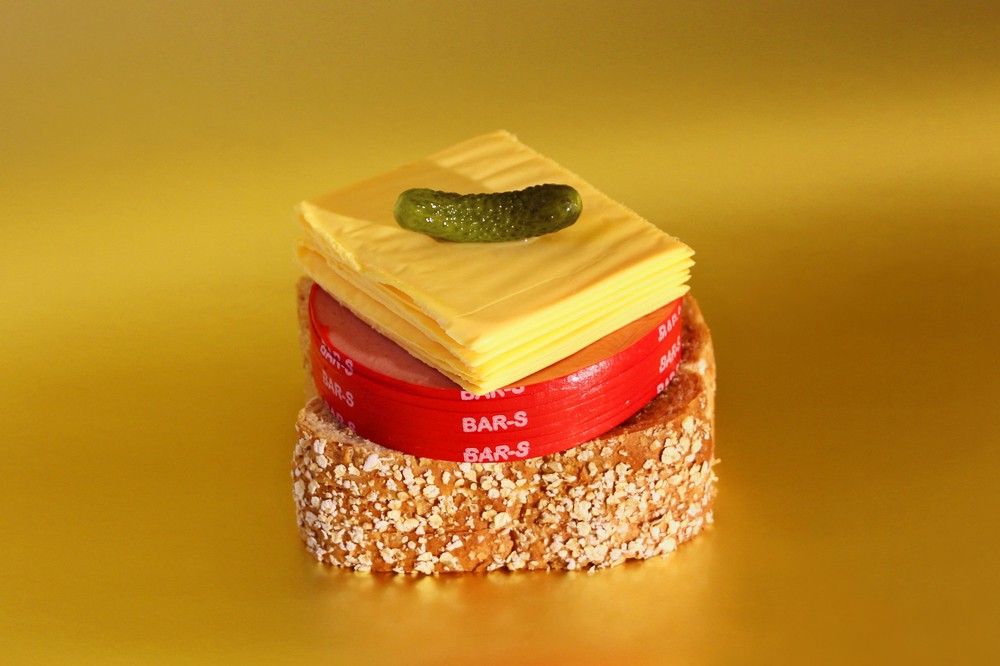Play With Your Food
What the gross food aesthetic means in a culture of Insta-food
An ode to the 1966 Czechoslovak film Daisies by Věra Chytilová, the 2014 Ex Hex music video for “Hot and Cold” reconstructs the visual delight of the consumption of mid-century-modern food. The camera pans in quick succession to various dishes — devilled eggs, green peas, devilled potatoes, jello salad — waiting to be devoured.
The presentation of food circa the 1950s has fallen out of good standing and is now a placeholder for the bad taste that we exhibited in the past. Dishes that at one time were meant to be visually pleasing, are now so firmly outdated that it has become a tongue-in-cheek trope of a gross food aesthetic. The gross food aesthetic can be found in magazine spreads, music videos, and high art. Why the resurgence of the unappealing food of the mid-century?
The gross food aesthetic isn’t limited to re-creations of mid-century-modern food, though it does take most of its inspiration from the unappealing food photography of that period. Examples of the popularity of the gross food aesthetic spans from the photography by artistic duo LAZY MOM, to Chloe Wise’s plastic food sculptures and portraits featuring food, to the popular Twitter account @70s_party, to Katy Perry’s music video for “Bon Appétit”. The use of gross food in art is so widespread that it has orbited around to being “cool.”

Arguably more so than any other gross food, jello salad (or aspic) has taken hold of the public’s imagination. To make jello salad, mix a packet of jello with water, sugar, and salt in a saucepan until dissolved. Stir in apple juice, lemon juice, and cold water. Place in the fridge for one hour. Prep salad ingredients: olives, pimentos, mushrooms, ham, shrimp, boiled eggs, etc. Mix into jello mix and pour into decorative mold. Refrigerate for four hours. Jello salad is grotesque not only in its artificial coloring, but in the knowledge that the sweet-tang of jello combined with savory ingredients likely tastes awful. But the purpose never was to consume the dishes orally, but instead visually.
Tamar Adler in her New York Times article “Betty Crocker’s Absurd, Gorgeous Atomic-Age Creations” writes,
Its recipes weren’t written to appeal to the palate. Their instructions were designed to make the Teenage Fondue or Party Sandwich Loaf look a certain way: theatrical, performative, misleading.
Now the aesthetic of Betty Crocker has been co-opted as an act of resistance against a culture that places too much emphasis on eating not only healthful food, but aesthetically pleasing food. The performative act of the food found in the Betty Crocker cookbook has shifted. It no longer works to impress and assert your skills at homemaking, but instead the opposite: it performs a resistance to our eating habits being dictated. The gross food aesthetic sends a message that you will eat however you’d like. The irony is not lost on me that to do this we utilize images of food, virtually unchanged from what they were intended to look like, that was supposed to represent the very thing we’re resisting.

As the Ex Hex music video “Hot and Cold” proceeds the members of the band — Mary Timony, Betsey Wright, and Laura Harris — consume the spread of gross food with unrestraint, followed by Timony walking across the decimated feast. The consumption of food that was never meant to be ate as much as looked at marks an act of defiance. The scenes from “Hot and Cold” directly recreate scenes from the Daisies by Chytilová where the main characters, both named Marie, make a pact to become decidedly bad. The mark of their badness stems from their relationship with food: during a dinner date that Marie II crashes they order an abundance of food and eat with abandon, when they come across a feast not meant for them they gorge themselves and destroy the room.


Women historically have had the role of homemaker thrust upon them. Cookbooks such as the Betty Crocker cookbook conform to the notion that women should know how to cook a certain way. While etiquette guides dictate the proper way to consume said food: daintily and in moderation. Today these rules are still thriving, yet more covert. Instagram and Pinterest work as wolves in sheep clothing, perpetuating the demand of living an aesthetically pleasing life. Sub jello salad for a chia seed kale smoothie, grand buffets for tasteful minimalism.
It’s hard to say whether we consume food more with our eyes or our mouths. The emphasis on food presentation is so engrained in our eating habits that it dates back to the 3rd century. Adler writes:
There is something very human in the desire to turn food, which we are impelled by biology to notice, into a spectacle. That desire is ancient — in the third century, Heliogabalus served peas mixed with gold pieces, lentils scattered with onyx — and went strong through the Middle Ages.
The emphasis on the visual aesthetic of food renders eating sacrilegious, a sign of gluttony.
At the end of Daisies, both Maries repent for their gluttony by attempting to clean up the banquet hall which they trashed and end up being crushed by the chandelier that hangs overtop the table. The message is clear: disobey the food rules society dictates, and heap the consequences. The end of the “Hot and Cold” music video diverges from its inspiration: Timony realizes the food-fight-protest was a daydream and she is still stuck with her dull date.
In both films, the characters revolt using gross food (that at one time wasn’t considered gross but akin to the aesthetically pleasing food photography found in todays magazines or Instagram) making us reconsider our relationship with food and the restraints put on how we present and eat food.

The technicolor images of LAZY MOM, a collaboration by Josie Keefe and Phyllis Ma, have been compiled into zines, and featured in the likes of Lucky Peach and Vice. Their content is the epiphany of gross food aesthetic. Jello salad makes numerous appearances, the gross factor heightened by the presence of red onions and pickles encased in gelatin, with birthday candles balanced on top. In an interview with Framework, Keefe explains “it’s about female guilt — doing kind of the “wrong thing” and focusing on something creative instead of what you’re supposed to do, or what society expects of you. Like feeding your kids.”
LAZY MOM’s message echoes that of Ex Hex’s. Keefe’s assertion that the overly-stylized photography of gross food represents female guilt and the “wrong thing” implies that creating food that is noticeably unappealing constitutes doing the wrong thing by not adhering to the visually pleasing standards that society sets out.

Lucky Peach was one of the utmost supporters of the gross food aesthetic; featuring not only LAZY MOM, but also their own execution of gross food. Raw chicken clutched by two hands, playdough pizza, food verging on genitalia. Helen Rosner in an Eater article titled “The Real Legacy of Lucky Peach is How it Looked” writes, “The whole thing was a blaring klaxon that Lucky Peach didn’t really care about whatever it was you’d been expecting to see. At its core, this is what the gross food aesthetic represents: not caring about what people expect to see and instead doing the opposite.

The notion that food that is now definitively unappetizing was at one time the height of popularity is fascinating—it’s the ultimate fall from grace. While furniture from the mid-century-modern lives on, the food of the same era has gone stale. The resurgence of the once desirable mid-century food rebranded as gross creates a dialogue with the past, at the same time critiquing the present. It pushes up against the aesthetically pleasing (for now) ways we display food, and goes against the picture perfect meals that Instagram and Pinterest suggest are the right way to make food. It all poses the question: how gross will our current food trends look in 50 years?
Tatum Dooley is a writer living in Toronto.